

Consider the following statements regarding the decline of the Indus valley civilization.
1. Climatic change
2. Civil war
3. Excessive floods
4. Foreign invasion
Which of the above are correct reasons for the decline of the Civilization?
a. 1 and 2
b. 2 and 3
c. 2 and 4
d. 1, 3 and 4
d. 1, 3 and 4
Give any two views about government and rulers of the Harappan society?
(i) Some archaeologists are of the opinion that Harappan society had no rulers and everybody enjoyed equal status.
(ii) Some other historians say that there was no single ruler but there were several rulers i.e. Mohenjodaro had a ruler, Harappan another, and so forth.
What languages and scripts were used in the Asokan inscriptions?
Prakrit was used in most Ashokan inscriptions, while Greek and Aramaic languages were used in northwest inscriptions. Brahmi script was used in Prakrit inscriptions, while Kharosthi script was used in northwest inscriptions.
How was paternal estate to be divided after the death of the parents according to Manusmriti?
a) The paternal estate was to be divided equally amongst sons after the death of the parents.
b) Eldest son got a special share in property.
c) Women could not claim a share of these resources.
Choose the correct option:
What does the motif of a woman, surrounded by lotuses and elephants depict?
A. Historians identify the figure as Yasodhara, the wife of Buddha.
B. Historians identify her with a popular goddess, Gajalakshmi.
C. The goddess of knowledge.
D. Historians identify her with a popular goddess, Durga.
B. Historians identify her with a popular goddess, Gajalakshmi.
The book ‘Buddha Gaya: The Heritage of Sakya Muni’ was written by _________.
Rajendra Lala Mitra
The Ain is made up of five books (daftars), of which the third book, mulk-abadi, is the one which deals with:
A: Civil administration and the establishment of servants
B: The fiscal side of the empire
C: Imperial household and its maintenance
D: Short biographical sketches of imperial officials
B: The fiscal side of the empire
Choose the correct option:
What is the literal meaning of antyaja?
A: Person who is born outside the caste system
B: Person who is born within the caste system
C: Person who does not follow the caste system
D: Person who follows the caste system
A: Person who is born outside the caste system
Who believe that on death the devotee will be united with Shiva and will NOT return to this world?
A: Nayanars
B: Lingayats
C: Alvars
D: Naths, Jogis and Siddhas
B: Lingayats
What did Bernier say in his account about Sati practice?
Francois Bernier mentioned that while some women seemed to embrace death cheerfully, others were forced to death.
Find out from the following pairs which one is correctly matched:
A. Abdul Hamid Lahori: Kitab-ul-Hind
B. Ramayana: Razmnama
C. Abu’l Fazl: Badshah Nama
D. Akbar Nama: Henry Beveridge
D: Akbar Nama: Henry Beveridge
Why did British administrators show interest to study Indian history?
They wanted to have a proper understanding about the subcontinent in order to understand the people and their cultures, so they could rule accordingly.
How did Bernier assess the Mughal Empire?
Francois Bernier described the Mughal Empire as one whose monarch was the King of “beggars and barbarians”, Mughal cities and towns were ruined and contaminated with “ill air” and its fields “overspread with bushes and full of “pestilential marishes”.
What were the main features of a South Indian town?
In the towns of South India, the principal focus was the temple. These towns were important commercial centres. Religious festivals often coincided with fares, linking pilgrimage with trade. The relationship that he had with other groups and classes determined their place in society and in the town.
Consider the following events”
1. Champaran Satyagraha
2. Ahmedabad Satyagraha
3. Kheda Satyagraha
4. Dandi Satyagraha
The correct chronological order of these events is:
a. 1, 2, 3, 4
b. 4, 3, 2, 1
c. 2, 1, 3, 4
d. 3, 4, 1, 2
a. 1, 2, 3, 4
Indicate which of the following options is NOT correct.
People used to settle in villages or visited villages as
A. They also flocked to towns during times of famine.
B. When towns were attacked, people often sought shelter in the countryside.
C. Mansabdars and jagirdars who were assigned territories in different parts of the empire usually maintained houses in villages.
D. Traders and peddlers took goods from the towns to sell in the villages.
C. Mansabdars and jagirdars who were assigned territories in different parts of the empire usually maintained houses in villages.
During the sixteenth and seventeenth centuries, the towns were famous as
A. Their monumental buildings and their imperial grandeur and wealth
B. Calcutta, Madras, and Bombay were important centres of imperial administration and control
C. Residence in these centres of power was symbolic of the status and prestige of a noble.
D. The focus of the town was oriented towards the palace and the principal mosque.
B. Calcutta, Madras and Bombay were important centres of imperial administration and control
Consider the following statements regarding the power of jotedars as more effective than that of the zamindars because
A: They lived in the villages.
B: Rent collection was a perennial problem.
C: They were close to the British.
D: They were close to the taluqdars.
Which of the following statement(s) is/are correct?
a. Only I
b. I and II
c. I and III
d.I, II and III
b: I and II
Assertion (A): The years immediately preceding the making of the Constitution termed as a time of great hope, but also of abject disappointment.
Reason (R): On 15 August 1947, India had been made free, but it had also been divided.
a. Both A and R are true and R is the correct explanation of A.
b. Both A and R are true but R is not the correct explanation of A.
c. A is true but R is false.
d. A is false but R is true.
a. Both A and R are true and R is the correct explanation of A.
Identify the following image and write its name.
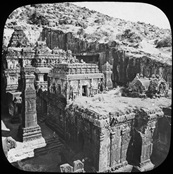
The image represents the Kailashnatha Temple, Ellora (Maharashtra). This entire structure is carved out of a single piece of rock.
Identify the following image and write its name.
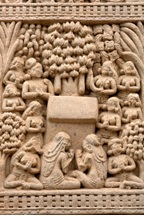
The image represents the worshipping the Bodhi tree Notice the tree, the seat, and the people around it.
How far is Mahabharata a useful source for the study of social history of Ancient India?
The Mahabharata is an important source for the study of social history of the subcontinent from 600 BCE to 600 CE.
The source helps historians to reconstruct the past. The epic has over a hundred thousand verses with rich information on a wide range of social categories and situations.
The text is described as itihasa (translated as history) and belongs to the early Sanskrit tradition.
The epic throws light on battles, forests, places and settlements.
Describe the significance of temple building in the Sacred Centre of Vijayanagara.
It is likely that the very choice of the site of Vijayanagara was inspired by the existence of the shrines of Virupaksha and Pamapadevi.
In fact, the Vijayanagara kings claimed to rule on behalf of the god Virupaksha.
Royal Portrait Sculpture was now displayed in temples and the king’s visit to the temples was treated as important state occasions on which he was accompanied by the important nayakas of the empire.
Why did the Paharias regularly raid the plains where settled agriculturists and traders lived?
These raids were necessary for their survival, particularly in years of scarcity.
The raids were a way of asserting power over settled communities and a means of negotiating political relations with outsiders.
The zamindars on the plains had to often purchase peace by paying a regular tribute to the hill chiefs.
Traders who passed through the Paharias’ dominated areas gave a small amount for permission to use the passes.
Once the toll was paid, the Paharia chiefs protected the traders, ensuring that their goods were not plundered by anyone.
Describe how art and literature helped in keeping alive the memory of 1857.
Art and literature have helped in keeping alive the memory of 1857. The leaders of the revolt were presented as heroic figures leading the country into battle, rousing the people to righteous indignation against oppressive imperial rule. Heroic poems were written about the valour of the queen who, with a sword in one hand and the reins of her horse in the other, fought for the freedom of her motherland.
In popular prints Rani Lakshmi Bai is usually portrayed in battle armour, with a sword in hand and riding a horse – a symbol of the determination to resist injustice and alien rule. These images did not only reflect the emotions and feelings of the times in which they were produced. They also shaped sensibilities. Nationalist imageries of the revolt helped shape the nationalist imagination.
Trace out the growth of Buddhism. Explain the main teachings of Buddha.
The Growth of Buddhism:
Buddhism grew rapidly both during the lifetime of the Buddha and after his death.
The Buddha preached in the languages of the ordinary people.
His messages of love and non-violence attracted many people who were dissatisfied with existing Brahmanical ritual practices. Buddhism emphasised on the importance of conduct and values rather than claims of superiority based on birth.
It insisted on the egalitarian ideas of metta (fellow feeling) and karuna (compassion) among the younger and weaker than oneself.
Buddhism became widely popular due to the Buddhist texts such as Tipitaka (the Vinaya Pitaka, Sutta Pitaka, and Abhidhamma Pitaka), the Dipavamsa and Mahavamsa, Ashokavadana, Jatakas and Buddhist hagiographies.
The main teachings of Buddha:
The world is transient (anicca) and constantly changing.
It is soulless (anatta) as there is nothing permanent or eternal in it.
Sorrow (dukkha) is intrinsic to human existence in this world.
Extinguish ego and desire to end the cycle of suffering.
Trace out how stupas were built. Explain why the stupa at Sanchi survived, but not at Amaravati.
Building of stupas:
The word stupa means a mound. There are several kinds of stupas, round and tall, big and small. According to inscriptions found on the railings and pillars of stupas, donations were made by kings such as the Satavahanas for building and decorating them.
Guilds such as the ivory workers financed part of one of the gateways at Sanchi.
Hundreds of women and men made donations; all their names along with their area names, occupations and names of their relatives were also inscribed on the pillars.
Bhikkhus and bhikkhunis also contributed towards building the stupas.
The stupa at Sanchi survived, but not at Amaravati:
The Sanchi Stupa survived because the rulers of Bhopal, Shahjehan Begum and her successor, Sultan Jehan Begum provided financial resources for its preservation
She built the museum and guest house where John Marshall stayed and popularised the Sanchi Stupa through his writings.
The Sanchi Stupa escaped from the teams of railway contractors, builders and artefacts hunters who looked for finds to carry away to the museums of Europe.
The Amaravati Stupa did not survive, because it was discovered before scholars understood the value of its preservation.
In 1854, Walter Elliot, the commissioner of Guntur (Andhra Pradesh), collected several sculpture panels and took them away to Madras.
By the 1850s, the carved slabs from Amaravati were taken to the Asiatic Society of Bengal at Calcutta, the India Office in Madras and museum in London.
Its stones were used by the local Raja in 1796 to build a temple.
Identify the relationship of the Alvars and Nayanars of Tamil Nadu with the State from the eighth to the eighteenth century.
During the early 1st millennium CE, there were several important chiefdoms in the Tamil region, followed by emergence of states during the second half of the 1st millennium CE, including the Pallavas and Pandyas (c. 6th-9th centuries CE). While Buddhism and Jainism had been prevalent in this region for centuries, drawing support from both mercantile and artisanal communities, both religions also received occasional royal patronage.
A major theme in the hymns of Tamil bhakti saint-poets, like the Alvars and the Nayanars, is their opposition to Buddhism and Jainism. This is particularly marked in Nayanar compositions. Historians have suggested that this was due to competition between members of other religious traditions for royal patronage. Later, the powerful Chola rulers (9th-13th centuries) supported Brahmanical and bhakti traditions, by making land grants and constructing temples for the deities, Vishnu and Shiva.
Some of the most magnificent Shiva temples, including those situated at places like Chidambaram, Thanjavur and Gangaikondacholapuram, were all constructed under Chola patronage. Simultaneously, some of the most spectacular representations of the deity – Shiva –in bronze sculpture were also produced. Artists were evidently inspired by the visions of the Nayanarsaints.
Both Nayanars and Alvars were revered by the Vellala peasants. Hence, it is not surprising that the rulers tried to win their support as well. In fact, the Cholas kings often attempted to claim divine support and simultaneously proclaim their own power and status by building splendid temples that were adorned with stone and metal sculpture, in order to recreate the visions of these popular saints who used to sing in the language of the common people.
These kings also introduced the singing of Tamil Shaiva hymns in the temples under royal patronage, while taking the initiative to collect and organise them into a text, called Tevaram. Moreover, inscriptional evidence from around 945 CE suggests that the Chola ruler Parantaka I, had consecrated the metal images of saint poets like Appar, Sambandar and Sundarar, all in a Shiva temple. Subsequently, these were carried in processions during the festivals celebrating these saints.
Identify the relationship between the Sufis and the State from the eighth to the eighteenth century.
A major feature of Sufi tradition, especially that of the Chishtis was austerity, including maintaining a distance from worldly power. However, this certainly did not mean absolute isolation from political power. Sufis accepted grants and donations from political elites, including rulers. The latter, in turn, set up charitable trusts (auqaf) as endowments for hospices and also granted tax-free land (inam).
Sufi orders, like Chishtis, accepted donations in both cash and kind. But rather than accumulate them, they spent them on immediate needs; like food, clothes, living quarters and ritual necessities (such as sama). All this enhanced the moral authority of the Sufi shaikhs, which attracted people from all corners of life. Further, Sufis’ piety and scholarship, and people’s belief in their miraculous powers made them popular among the masses, whose support was required by kings.
Kings did not just need to demonstrate their association with Sufis; they also required their legitimacy. When the Turks set up the Delhi Sultanate, they resisted the insistence of the ulamaon imposing shari‘aas state law, as they anticipated opposition from their subjects, the majority of them being non-Muslims. Instead, the Sultans sought the Sufis – who directly derived their authority from God – and did not depend on jurists to interpret the Shari‘a.
Besides, it was also believed that the auliya could intercede with God to improve the material and spiritual conditions of ordinary humans. For this reason, kings often wanted their tombs to be in the vicinity of Sufi shrines and hospices.
However, there were instances of conflict between both Sultans and Sufis. To assert their authority, both expected that performance of certain rituals, such as prostration and kissing of the feet. Occasionally, a Sufi Shaikh was addressed with high-sounding titles. For example, Nizamuddin Auliya’s disciples addressed him as sultan-ul-mashaikh (literally, Sultan amongst shaikhs).
Other Sufis, like Suhrawardis, under Delhi Sultans, and Naqshbandis, under Mughals, were also associated with the state. However, the modes of their association were different from those of the Chishtis. In some cases, including from these orders, Sufis accepted courtly offices.
“The Salt March of 1930 was the first event that brought Mahatma Gandhi to world attention.” Explain the significance of this movement for Swaraj.
The Salt March of 1930 was significant for several reasons.
In the end of December 1929, the Congress held its annual session in Lahore, in which it proclaimed its commitment to “Purna Swaraj” (complete independence).
On 26th January 1930, “Independence Day” was observed, with the National Flag hoisted in different venues, and patriotic songs sung. Gandhiji suggested that ‘Independence Day’ celebrations would begin with hoisting of the National Flag.
On this day, participants pledged that it was “the inalienable right of the Indian people, as of any other people, to have freedom and to enjoy the fruits of their toil”, and that “if any government deprives a people of these rights and oppresses them, the people have a further right to alter it or abolish it”.
After observance of “Independence Day”, Mahatma Gandhi announced that he would lead a march to break a widely disliked law in British India, which gave the State a monopoly in salt manufacturing and selling.
This displayed Gandhi’s tactical wisdom. Although salt was indispensable for all Indians; people were forbidden from making salt even for domestic use.
State monopoly over salt was deeply unpopular; by targeting it, Gandhiji hoped to mobilise a wider discontent against British.
While most Indians understood the significance of Gandhiji’s challenge, the British apparently did not.
On 12th March 1930, Gandhiji started from his Sabarmati Ashram towards the Ocean.
He reached Dandi three weeks later, making a fistful of salt, thereby making himself a criminal in the law’s eyes.
It was the Salt March that first brought Gandhiji to world attention.
It was widely covered by European and American press. Time Magazine saluted Gandhiji as a “Saint” and “Statesman”, who was using “Christian acts as a weapon against men with Christian beliefs”.
It was the first nationalist activity that witnessed large-scale participation of women.
It made the British realise that their rule would not last forever, and that they had to devolve some power to the Indians.
How partition affected various parts of India? Explain the role of Gandhiji in preserving communal harmony in the face of partition and consequent violence.
The experiences of ordinary people we have been discussing so far relate to the north-western part of the subcontinent. While carnage occurred in Calcutta and Noakhali in 1946, the Partition was most bloody and destructive in the Punjab. The near-total displacement of Hindus and Sikhs eastwards into India from West Punjab and of almost all Punjabi-speaking Muslims to Pakistan happened in a relatively short period of two years between 1946 and 1948. Many Muslim families of Uttar Pradesh, Bihar, Madhya Pradesh and Hyderabad in Andhra Pradesh continued to migrate to Pakistan through the 1950s and early 1960s, although many chose to remain in India. Most of these Urdu-speaking people, known as muhajirs (migrants) in Pakistan moved to the Karachi-Hyderabad region in Sind.
In Bengal the migration was even more protracted, with people moving across a porous border. This also meant that the Bengali division produced a process of suffering that may have been less concentrated but was as agonising. Furthermore, unlike the Punjab, the exchange of population in Bengal was not near-total. Many Bengali Hindus remained in East Pakistan while many Bengali Muslims continued to live in West Bengal. Finally, Bengali Muslims (East Pakistanis) rejected Jinnah’s two-nation theory through political action, breaking away from Pakistan and creating Bangladesh in 1971-72. A common religion could not hold East and West Pakistan together. There is, however, a huge similarity between the Punjab and Bengal experiences. In both these states, women and girls became prime targets of persecution. Attackers treated women’s bodies as territory to be conquered. Dishonouring women of a community was seen as dishonouring the community itself, and a mode of taking revenge.
Amidst all this turmoil, one man’s valiant efforts at restoring communal harmony bore fruit. The 77-year-old Gandhiji decided to stake his all in a bid to vindicate his lifelong principle of non-violence, and his conviction that people’s hearts could be changed. He moved from the villages of Noakhali in East Bengal (present-day Bangladesh) to the villages of Bihar and then to the riot-torn slums of Calcutta and Delhi, in a heroic effort to stop Hindus and Muslims kill each other, careful everywhere to reassure the minority community. In October 1946, Muslims in East Bengal targeted Hindus. Gandhiji visited the area, toured the villages on foot, and persuaded the local Muslims to guarantee the safety of Hindus. Similarly, in other places such as Delhi he tried to build a spirit of mutual trust and confidence between the two communities. Gandhiji continued to be in Delhi, fighting the mentality of those who wished to drive out every Muslim from the city, seeing them as Pakistani. When he began a fast to bring about a change of heart, amazingly, many Hindu and Sikh migrants fasted with him.
The effect of the fast was “electric”, wrote Maulana Azad. People began realising the folly of the pogrom they had unleashed on the city’s Muslims but it was only Gandhiji’s martyrdom that finally ended this macabre drama of violence. “The world veritably changed,” many Delhi Muslims of the time recalled later.
The most ancient system yet discovered
About the drains, Mackay noted: “It is certainly the most complete ancient system as yet discovered.” Every house was connected to the street drains. The main channels were made of bricks set in mortar and were covered with loose bricks that could be removed for cleaning. In some cases, limestone was used for the covers. House drains first emptied into a sump or cesspit into which solid matter settled while waste water flowed out into the street drains. Very long drainage channels were provided at intervals with sumps for cleaning. It is a wonder of archaeology that “little heaps of material mostly sand, have frequently been found lying alongside drainage channels, which shows…. that the debris was not always carted away when the drain was cleared”.
Drainage systems were not unique to the larger cities, but were found in smaller settlements as well. At Lothal for example, while houses were built of mud bricks, drains were made of burnt bricks.
a. Explain the ancient drainage system of the Harappans.
b. Explain the domestic architecture of the houses of Mohanjodaro.
c. What are the advantages of covered drains? Explain.
a. In the Harappan cities, each house was connected with a street drain. The main channels were made of bricks set in mortar and were covered with loose removable bricks to allow proper cleaning of the drains. The pits were provided so that the solid matter could not flow into the street drains.
b. Rooms of the houses were located around the courtyard. Privacy of a house was maintained as there were no windows on the ground level and direct view of the house was not possible from outside. There was a provision of bathroom in each house. Staircases have been found in some houses. This provides the evidence of the two-storeyed houses. Wells were also found in many houses.
c. Covered drains add to the width of the road and show one of the features of planned lay-out. Covered drains are also more hygienic than the open drains.
Classification of lands under Akbar
The following is a listing of criteria of classification excerpted from the Ain:
The Emperor Akbar in his profound sagacity classified the lands and fixed different revenue to be paid by each. Polaj is land which is annually cultivated for each crop in succession and is never allowed to lie fallow. Parauti is land left out of cultivation for a time that it may recover its strength. Chachar is land that has lain fallow for three or four years. Banjar is land uncultivated for five years and more. Of the first two kinds of land, there are three classes, good, middling, and bad. They add together the produce of each sort, and the third of this represents the medium produce, one-third part of which is exacted as the Royal dues.
a. Explain briefly the classification of land by Akbar.
b. How the revenue was fixed for the first two types of lands?
c. Suggest some other way as you feel better.
a. Akbar classified the lands as follows:
Polaj: is the land cultivated annually for each crop in succession and is never allowed to lie fallow.
Paruti: is a land left out of cultivation for a time that it may recover its strength. Chachar: is the land that has lain fallow for three or four years.
Banjar: is the land uncultivated for five years and more.
b. The first two kinds of land were divided into three classes, good, middling and bad. The produce of each sort was added together and 1/3rd of the produce was extracted as royal dues.
c. Kankut would be a better method of revenue collection. In Kankut, revenue would be assured on the basis of standing grains.
What should the qualities of a national language be?
A few months before his death Mahatma Gandhi reiterated his views on the language question:
This Hindustani should be neither Sanskritised Hindi nor Persianised Urdu but a happy combination of both. It should also freely admit words wherever necessary from the different regional languages and also assimilate words from foreign languages, provided that they can mix well and easily with our national language. Thus our national language must develop into a rich and powerful instrument capable of expressing the whole gamut of human thought and feelings. To confine oneself to Hindi or Urdu would be a crime against intelligence and the spirit of patriotism.
a. Explain the views of Gandhiji about the qualities of the national language we should have.
b. Explain what the Congress had accepted by 1930 about the shape of our national language.
c. Explain what qualities Hindustani language possesses.
a. Gandhiji was of the opinion that the national language should be neither Sanskritised Hindi nor Persianised Urdu, but the combination of both. He also opined that everyone should speak in a language that common people can easily understand.
b. By the 1930s, the Congress had accepted that Hindustani ought to be the national language.
c. Hindustani is a language spoken by a large section of the people in India. It is a blend of Hindi and Urdu.
(i) On the given political outline map of India, locate and label the following with appropriate symbols: (1+1+1 = 3 marks)
a. Amritsar - an important centre of the National Movement
OR
Ajmer, a territory under Mughals
b. Agra - a territory under Babur
OR
Gwalior, a centre of the Revolt of 1857
c. Rakhigarhi
(ii) On the same political outline map of India, three places which are major Buddhist sites have been marked as A, B and C. Identify them and write their correct names on the lines drawn near them. (3 marks)
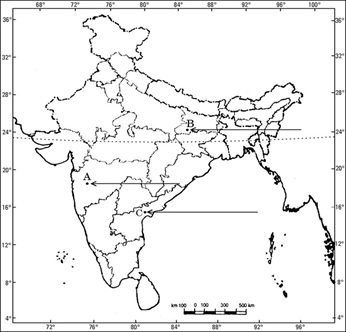
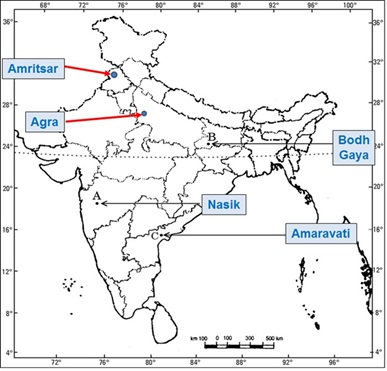
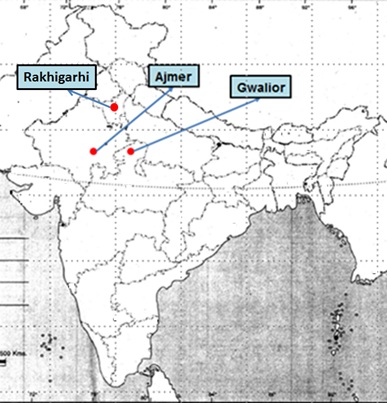

Take your CBSE board preparation to another level with AI based and rich media animation on Extramarks - The Learning App.
Features of Learning App